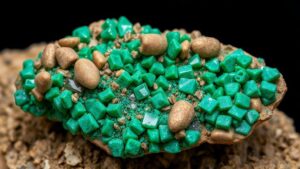Excavating dinosaur tracks in the desert plateaus of Utah’s Grand Staircase-Escalante.
Excavating Dinosaur Tracks in the Desert Plateaus of Utah’s Grand Staircase-Escalante
The Grand Staircase-Escalante National Monument in Utah is a treasure trove for rockhounds and mineral collectors, featuring an astonishing array of geological formations and fossils. Among these, dinosaur tracks stand out as captivating remnants of the prehistoric world. This article delves into the significance of these tracks, the techniques used to excavate them, and practical tips for enthusiasts interested in this unique aspect of paleontology.
The Significance of Dinosaur Tracks
Dinosaur tracks, also known as ichnites, provide invaluable insight into the behavior, movement, and environment of these ancient creatures. Grand Staircase-Escalante area is notable for its rich Triassic to Cretaceous fossil beds, which exhibit a variety of dinosaur prints. According to the Bureau of Land Management (BLM), over 1,000 distinctive tracks have been documented in Utah alone, offering a glimpse into the diverse ecosystems that existed millions of years ago.
For example, the tracks found in the Entrada Sandstone, dated to approximately 170 million years ago, highlight the presence of herbivorous and theropod dinosaurs. Studies indicate that such tracks can reveal information about the size of the dinosaurs–as large as 20 feet long for certain sauropod tracks–and their social behaviors, such as herd movements.
Techniques for Excavating Dinosaur Tracks
Excavating dinosaur tracks requires meticulous planning, knowledge, and respect for the surrounding environment. following techniques are employed by paleontologists and collectors:
- Site Identification: Before excavation, it is essential to locate tracks using geological maps and field surveys. Topographic maps that indicate elevations and potential outcroppings of sedimentary rock can help guide collectors to promising sites.
- Surface Preparation: The top layer of sediment or overburden is typically removed to expose the tracks. Hand tools such as chisels and brushes are used to carefully uncover the prints without damaging them.
- Documentation: Detailed documentation, including photographs and sketches, is crucial. This records the tracks position, orientation, and other geological relationships.
- Mold Making: When removing tracks from their natural setting, creating a mold using plaster or silicone is recommended. This allows collectors to preserve the track while leaving the original in place for ongoing research and public education.
Real-World Applications
The excavation of dinosaur tracks transcends mere rockhounding; it contributes to scientific research and education. Findings from Utahs sites have been published in various scientific journals, shedding light on dinosaur locomotion and behavior. For rockhounds, these endeavors present both a hobby and a chance to contribute to the broader understanding of paleontology.
Also, excavated dinosaur tracks are often displayed in museums, promoting public interest in geology and prehistoric life. By participating in excavation projects, collectors can assist in the preservation of these important sites while learning about the delicate balance between exploration and conservation.
Tips for Rockhounds and Mineral Collectors
For those interested in exploring the dinosaur tracks of the Grand Staircase-Escalante region, here are some practical tips:
- Research and Permissions: Always conduct thorough research about the area and obtain necessary permits before proceeding with any excavation, as many sites are protected under federal law.
- Join Local Groups: Connecting with local rockhound societies or paleontological organizations can provide additional resources, including guided excursions where you can learn from experienced excavators.
- Be Prepared: The desert environment can be harsh; appropriate gear such as sunblock, sturdy shoes, and plenty of water is crucial for fieldwork.
- Respect Nature: Follow the principles of Leave No Trace to minimize your impact on the environment and preserve these irreplaceable natural resources.
Conclusion
Excavating dinosaur tracks in the desert plateaus of Utah’s Grand Staircase-Escalante is not just an exciting adventure for rockhounds and mineral collectors; it is also a gateway to understanding our planets ancient history. By learning the significance of these tracks, mastering excavation techniques, and approaching the activity responsibly, enthusiasts can play an integral role in the ongoing exploration of our earths prehistoric past. With careful planning and respect for the environment, the discovery of dinosaur tracks can be a rewarding experience that enriches both knowledge and appreciation for geology and paleontology.


